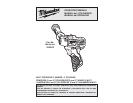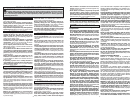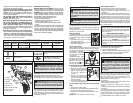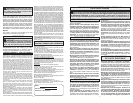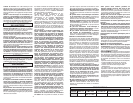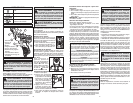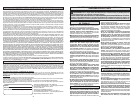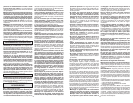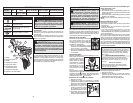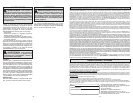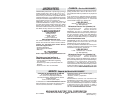
4
5
propel the tool in direction opposite to the wheel’s
movement at the point of snagging.
• Use special care when working corners, sharp
edges etc. Avoid bouncing and snagging the ac-
cessory. Corners, sharp edges or bouncing have a
tendency to snag the rotating accessory and cause
loss of control or kickback.
• Do not attach a saw chain woodcarving blade or
toothed saw blade. Such blades create frequent
kickback and loss of control.
Safety Warnings Specifi c for Sanding Operations:
• Do not use excessively oversized sanding disc
paper. Follow manufacturers recommendations,
when selecting sanding paper. Larger sanding
paper extending beyond the sanding pad presents a
laceration hazard and may cause snagging, tearing
of the disc or kickback.
Safety Warnings Specifi c for Polishing Operations:
• Do not allow any loose portion of the polishing
bonnet or its attachment strings to spin freely.
Tuck away or trim any loose attachment strings.
Loose and spinning attachment strings can entangle
your fi ngers or snag on the workpiece.
Cat. No. Volts DC No Load RPM
Spindle
Thread Size
Sanding Disc
Diameter
Polishing Pad
Diameter
2438-20 12 High 0 - 8 300
Low 0 - 2 800
M9 x 0.75 2" 3"
FUNCTIONAL DESCRIPTION
SPECIFICATIONS
ASSEMBLY
WARNING Recharge only with the
charger specifi ed for the battery. For specifi c
charging instructions, read the operator’s
manual supplied with your charger and battery.
Inserting/Removing the Battery
To remove the battery, push in the release buttons
and pull the battery pack away from the tool.
To insert the battery, slide the pack into the body of
the tool. Make sure it latches securely into place.
1. Trigger
2. Trigger lock
3. Spindle
4. Side handle
5. Spindle lock
6. Side handle sockets
7. Speed control
8. Fuel gauge
Installing Side Handle
The side handle may be installed on either side of
the gear case. Position side handle in the location
which offers best control and guard protection. To
install, thread side handle into side handle socket
and tighten securely.
WARNING Always remove battery
pack before changing or removing accesso-
ries. Only use accessories specifi cally recom-
mended for this tool. Others may be hazardous.
SYMBOLOGY
Volts
No Load Revolutions per Minute
(RPM)
Direct Current
C
US
Underwriters Laboratories, Inc.
United States and Canada
1
4
5
6
7
3
2
8
Fuel Gauge
To determine the amount of charge left in the bat-
tery, pull the trigger. The Fuel Gauge will light up
for 2-3 seconds.
To signal the end of charge, 1 light on the fuel gauge
will fl ash for 2-3 seconds.
Selecting Speed
The speed selector is on top of the
motor housing. Allow the tool to come
to a complete stop before changing
speeds.
1. For Low speed, push the speed
selector to display “1”.
2. For High speed, push the speed
selector to display “2”.
Locking the Trigger
Always allow the motor to come to a complete stop
before locking the trigger. Always lock the trigger
or remove the battery pack before performing
maintenance, changing
accessories, storing the
tool and any time the tool
is not in use.
To lock the trigger, push
the trigger lock from the
LOCK side of the tool.
To unlock, push the trig-
ger lock to the UN-
LOCK side of the tool.
Installing Backing Pads
1. Remove the battery pack.
2. Wipe the accessories and
spindle to remove dust and
debris. Inspect the parts
for damage. Replace if
needed.
3. Press in the spindle lock
and thread the backing
pad into the spindle. Hand
tighten securely.
4. To remove backing pad, remove the battery pack
and reverse the procedure.
Installing/Removing Hook and Loop Polishing
Pads
1. Remove the battery pack.
2. To install, line up the polishing pad with the back-
ing pad and press fi rmly onto the tool.
3. To remove, pull the polishing pad off of the back-
ing pad.
NOTE: Use side handles for better control.
OPERATION
WARNING Always remove battery
pack before changing or removing acces-
sories. Only use accessories specifically
recommended for this tool. Others may be
hazardous.
WARNING To reduce the risk of injury,
wear safety goggles or glasses with side shields.
LOCK
.
UNLOCK
Additional Safety Warnings
• Maintain labels and nameplates. These carry im-
portant information. If unreadable or missing, contact
a MILWAUKEE service facility for a free replacement.
• WARNING: Some dust created by power sanding,
sawing, grinding, drilling, and other construction ac-
tivities contains chemicals known to cause cancer,
birth defects or other reproductive harm.
Some examples of these chemicals are:
• lead from lead-based paint
• crystalline silica from bricks and cement and
other masonry products, and
• arsenic and chromium from chemically-treated
lumber.
Your risk from these exposures varies, depending on
how often you do this type of work. To reduce your
exposure to these chemicals: work in a well ventilat-
ed area, and work with approved safety equipment,
such as those dust masks that are specially designed
to fi lter out microscopic particles.
Sanding Disc Selection
Use sanding discs and accessories that are:
• correct size as written on tool’s nameplate.
• rated at or above the RPM listed on the tool’s
nameplate.
• correct accessory, wheel type and grit for the job.
Refer to the table below to select the correct type
of sanding disc for your job. Generally, use 24 or
36 grit for heavy stock removal; 50, 60, or 80 grit
for medium stock removal and 120 grit for fi nishing.
Always begin with a coarse grit, using successively
fi ner grits to obtain the desired fi nish. See your
MILWAUKEE Electric Tool Catalog for a complete
list of sanding discs.
Maintaining Tool
Keep your tool, battery pack and charger in good
repair by adopting a regular maintenance program.
After six months to one year, depending on use,
return the tool, battery pack and charger to A
MILWAUKEE service facility for:
• Lubrication
• Mechanical inspection and cleaning (gears, spin-
dles, bearings, housing, etc.)
• Electrical inspection (battery pack, charger,
motor)
• Testing to assure proper mechanical and electrical
operation
If the tool does not start or operate at full power
with a fully charged battery pack, clean the contacts
on the battery pack. If the tool still does not work
properly, return the tool, charger and battery pack,
to a MILWAUKEE service facility for repairs.
MAINTENANCE
WARNING To reduce the risk of injury,
always unplug the charger and remove the
battery pack from the charger or tool before
performing any maintenance. Never disas-
semble the tool, battery pack or charger.
Contact a MILWAUKEE service facility for
ALL repairs.
Aluminum Oxide
For fast cutting, general purpose discs for most
metal jobs. Best for cold-rolled steel, stainless
steel or metals requiring tough, fast cutting, long
lasting abrasives.
Aluminum Zirconia Bi-Cut
Unique grit pattern is arranged in clusters for fast-
er stock removal and cleaning. Ideal for removing
paint from cars, boats, etc. without clogging.
Ceramic
Lasts up to 3 times longer than Aluminum Ox-
ide Discs. For general metal working. Ideal for
tough jobs.
Installing/Removing Sanding Discs
Use Roloc™ type sanding discs.
1. Remove the battery pack.
2. Press in the spindle lock and thread sanding disc
onto the backing pad. Hand tighten securely.
3. To remove, reverse the procedure.



